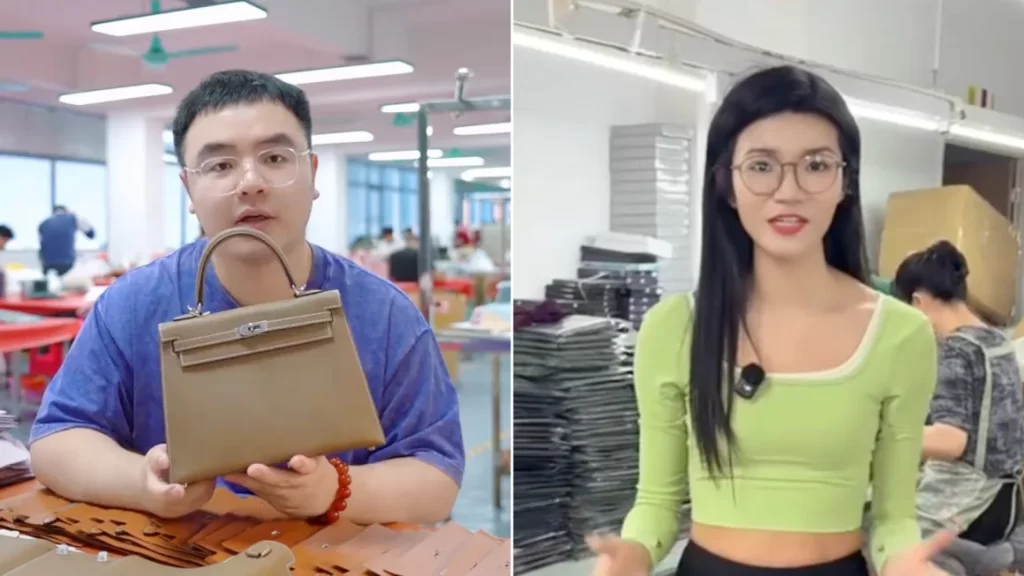Chinese Factories Flood TikTok to Dodge Trump’s 145% Tariffs And Stir Luxury Brand Confusion
As President Donald Trump’s proposed 145% tariffs on Chinese imports loom, Chinese suppliers are finding a new way to reach American consumers—straight through TikTok. Social media has become the latest battleground in the trade war, with viral videos urging U.S. shoppers to buy directly from manufacturers in China and bypass retail middlemen altogether.
One user, Wang Sen, stood in front of what appeared to be high-end Hermès Birkin bags, claiming to be the original equipment manufacturer (OEM) behind luxury brands. “Why don’t you just contact us and buy from us? You won’t believe the prices,” he said. The video was removed shortly after—but not before apps like DHgate and Taobao surged to #2 and #7 on the U.S. Apple App Store, respectively.
Experts, however, caution that these so-called OEM sellers likely aren’t affiliated with actual luxury brands like Lululemon or Chanel. Real OEMs are bound by non-disclosure agreements, and it’s rare they’d go public—let alone post on TikTok.
Fake Luxury? Lululemon, Chanel Refute Claims in Viral Videos
In one of the most viral TikToks, a user named LunaSourcingChina pointed to factories in Yiwu, China, claiming that $98 Lululemon leggings were being sourced directly from there—for as low as $5.

Lululemon quickly issued a statement: “We do not work with the manufacturers identified in the online videos and urge consumers to be aware of counterfeit products and misinformation.” The factories named also don’t appear in Lululemon’s publicly available April 2025 supplier list.
Experts say it’s more likely that these videos showcase dupes—high-quality counterfeits—that violate trademark laws. If they were genuine suppliers, they’d be under strict confidentiality agreements. “They definitely wouldn’t be publicly selling those big-name products online,” said Hao Dong, senior lecturer at the University of Southampton.
Where Are Luxury Goods Really Made?
The viral narrative that “80% of luxury bags are made in China” isn’t exactly accurate—but it’s not totally false either. Professor Regina Frei from the University of the Arts London explained that many luxury items are preassembled or have components produced in China before final assembly in Europe.
“It’s not a clear yes or no,” she said. “Expensive handbags might have parts made in China, but final assembly happens in France or Italy.”
Brands like Hermès, for example, go beyond the legal requirements of “Made in France” labels. Their design, sourcing, cutting, and assembly are all done in French regions like Pantin and Normandy. France’s Origine France Garantie label ensures over 50% of a product’s cost is derived from operations in France, offering further consumer trust.
What About U.S. and EU Labeling Laws?
Both the U.S. and EU have strict labeling standards. The FTC requires a product labeled “Made in USA” to be “all or virtually all” sourced and assembled in the country. Similarly, in France and Italy, “Made in” labels are granted only if the final transformation of the product occurred locally.
In other words, even if a Chinese factory builds most of a bag, unless the last major manufacturing step is done in France or Italy, it can’t legally carry those national labels.
Environmental and Economic Costs of Direct-From-China Shopping
While buying direct from Chinese sellers may sound appealing, it comes at a cost. Professor Frei warned that the explosion of platforms like Shein and Temu—and the soon-to-expire de minimis tax exemption for packages under $800—has created an environmental disaster. Most packages are plastic-wrapped and flown individually, contributing heavily to global carbon emissions.
“This is not sustainable,” Frei said. “And many of these items quickly end up in landfills.”
TikTok’s Role in the Trade War
TikTok has become ground zero for misinformation and clever marketing disguised as behind-the-scenes factory access. Despite the app removing some of these viral videos, the damage is done. One comment summed it up best: “Now this is how you do a trade war.”
Yet consumers are left grappling with questions about authenticity, ethics, and environmental impact. “If China stopped producing, our shops would be empty,” said Frei.








